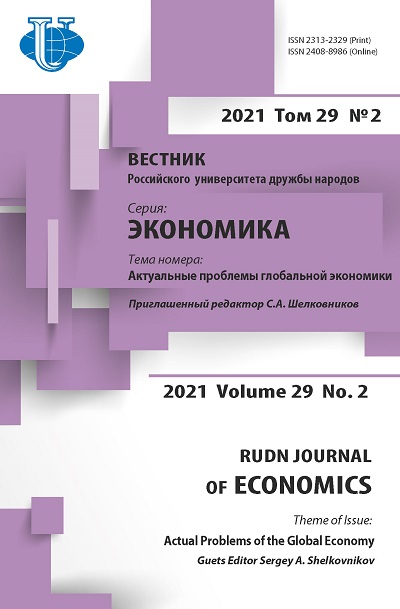Instruments for implementing China's economic interests in the developing countries on the example of Sub-Saharan Africa
- Authors: Biryukov D.Y.1, Dyuzheva N.V.1
-
Affiliations:
- Peoples’ Friendship University of Russia (RUDN University)
- Issue: Vol 29, No 2 (2021): ACTUAL PROBLEMS OF THE GLOBAL ECONOMY
- Pages: 426-438
- Section: Developed and developing countries economy
- URL: https://journals.rudn.ru/economics/article/view/26900
- DOI: https://doi.org/10.22363/2313-2329-2021-29-2-426-438
Cite item
Full Text
Abstract
The article examines China’s foreign economic policy in the developing countries of Sub-Saharan Africa. The purpose of the study is to determine what financial and nonfinancial instruments the PRC uses to implement its economic interests in the region. The relevance of the study is due to the increased role of China in the economies of the region, its active investment and lending policy, which in theory can lead to the emergence of “debt traps”, and the spread of “soft power”. To determine the scale of interaction, a general statistical analysis of trade and economic cooperation between the PRC and the countries of the region is provided, and its structure is determined. The institutional framework is studied, for example, the China - Africa Cooperation Forum, and the main instruments which are used to implement the economic interests of the PRC are given, such as the Belt and Road Initiative and investments within its framework, credit policy, assistance in the creation of SEZ, individual elements of “soft power”. The systematization of such instruments makes it possible to assess China’s place in the region in more detail and identify potential risks for developing countries. The implications of the utilization of such instruments in the context of the economic development and economic security of African countries are determined based on the results of the study.
About the authors
Danila Yu. Biryukov
Peoples’ Friendship University of Russia (RUDN University)
Author for correspondence.
Email: dbirukov22@gmail.com
PhD student, International Economic Relations Department, Faculty of Economics
6 Miklukho-Maklaya St, Moscow, 117198, Russian FederationNataliya V. Dyuzheva
Peoples’ Friendship University of Russia (RUDN University)
Email: dioujeva@yandex.ru
Ph.D in Economics, Associate Professor, International Economic Relations Department
6 Miklukho-Maklaya St, Moscow, 117198, Russian FederationReferences
- Alemu, D., & Tugendhat, H. (2016). Chinese agricultural training courses for African officials: Between power and partnerships. World Development, 81, 71-81. http://dx.doi.org/10.1016/j.worlddev.2016.01.022
- Dollar, D. (2016). China’s engagement with Africa. From natural resources to human resources. Washington, DC: Brookings.
- Morris, S., Parks, B., & Gardner, A. (2020). Chinese and World Bank lending terms: A systematic comparison across 157 countries and 15 years: Center for Global Development Policy paper. Washington, DC: Center for Global Development.
- Borokh, O.N., & Lomanov, A.V. (2012). From “soft power” to “cultural might”. Valdai Notes (no. 4). (In Russ.) Retrieved December 6, 2020, from https://globalaffairs.ru/number/Otmyagkoi-sily-k-kulturnomu-moguschestvu-15643
- Deych, T.L. (2019). China’s facilitation of the industrialization of African countries. Asian and African Countries: Economic, Social, Political, Ethno-Confessional Problems (pp. 36-44). Moscow, Institute of Oriental Studies of the Russian Academy of Sciences. (In Russ.)
- Safronova, E.I. (2018). China and African, Latin American and Middle Eastern countries. People's Republic of China: Politics, Economy, Culture: 2017-2018 (pp. 321-336). Moscow: Forum Publ. (In Russ.)
- Victorien, A. (2014). Chinese expansion mechanism in Africa. RUDN Journal of International Relations, (1), 78-84. (In Russ.)
- Victorien, A. (2013). The particularity of the investment cooperation between China and African countries. RUDN Journal of Economics, (3), 56-64. (In Russ.)
- Belyaev, S., & Makarova, I. (2018, March 5). Chinese investments in Africa: Practice of the China - Africa Development Fund. Russian International Affairs Council. (In Russ.) Retrieved November 16, 2020, from https://russiancouncil.ru/analytics-and-comments/ columns/africa/kitayskie-investitsii-v-afrike-praktika-fonda-razvitiya-kitay-afrika/
- Xinhuanet. (2018, September 1). China - Africa Development Fund reaches 10 bln USD. Retrieved November 21, 2020, from http://www.xinhuanet.com/english/2018-09/01/ c_137437000.htm
- Tiezzi, S. (2018, September 5). FOCAC 2018: Rebranding China in Africa. The Diplomat. Retrieved November 16, 2020, from https://thediplomat.com/2018/09/focac-2018rebranding-china-in-africa
- Xinhua News. (2018, December 5). The number of Confucius Institutes in the world has reached 548. (In Russ.) Retrieved November 21, 2020, from http://russian.news.cn/ 2018-12/05/c_137652677.htm
- Green, M. (2019, April 25). China’s debt diplomacy. Foreign Policy. Retrieved December 6, 2020, from https://foreignpolicy.com/2019/04/25/chinas-debt-diplomacy/
- Garcia-Herrero, A., & Xu, J. (2019, July 22). China’s investment in Africa: What the data really says, and the implications for Europe. Bruegel. Retrieved December 7, 2020, from https://www.bruegel.org/2019/07/chinas-investment-in-africa-what-the-data-reallysays-and-the-implications-for-europe/
- Nyabiage, J. (2019, November 17). Ghana goes ahead with US$2 billion Chinese bauxite barter deal that has conservationists up in arms. South China Morning Post. Retrieved December 7, 2020, from https://www.scmp.com/news/china/diplomacy/article/3037993/ ghana-goes-ahead-us2-billion-chinese-bauxite-barter-deal-has
- Xinhuanet. (2019, December 10). China, Africa join for broader agricultural cooperation. Retrieved December 6, 2020, from http://www.xinhuanet.com/english/2019-12/10/ c_138621136.htm















